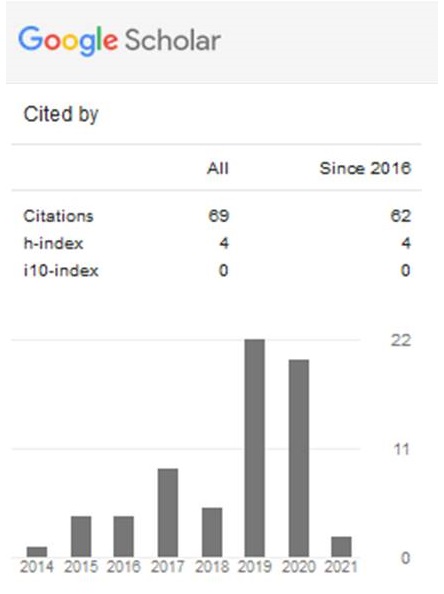Synthetic insecticide test for Sycanus croceovittatus Dohrn. predator of Setora nitens Walker. caterpillar pest oil plants (Elaeis guineensis Jacq.)
Abstract
Sycanus croceovittatus Dohrn. is one of the predators of the Setora nitens Walker caterpillar pest. in oil palm plant. Control of caterpillar pest Setora nitens commonly used is synthetic insecticides, but its unwise use can cause the death of predator S. croceovittatus. The research was conducted at the Field PHT Laboratory, Faculty of Agriculture, Riau University, Pekanbaru from July to August 2018. This study aims to determine the effect of synthetic insecticides on natural enemies S. croceovittatus in controlling S. nitens caterpillar pests. This study was conducted experimentally using a completely randomized design (CRD) with four treatments and five replications. The treatments used were treatments without insecticides, profenofos, deltamethrin and sipermetrin. The treatment of synthetic insecticides has a negative impact on the decline of predator population S. croceovittatus with total mortality of synthetic insecticides made from active profenofos by 30%, insecticides made from deltamethrin by 26.7%, and insecticides made from sipermetrin by 30% with 2 ml.l-1 water synthetic insecticide.
Keywords
Full Text:
PDFReferences
Bhanu, S., S. Archana, K. Ajay, Bhatt, J.L. Bajpai, S.P. P.S. Singh, B. Vandana. 2011. Impact of deltamthrin, us as an insecticide and its bacterial degradation a preliminary study. Journal enviro. 1 : 977-985.
Croft, B. A. 1990. Arthropod Biological Control Agents and Pesticides. Jhon Wiley & Sons Publishing. New York.
Dadang dan Prijono. 2008. Insektisida Nabati. Departemen Proteksi Tanaman Institut Pertanian Bogor. Bogor.
Delpuech, J., M. Legallet., B. Terrier., and O., Fouillet. 1996. Modifications of the sex pheromonal communication of Trichogramma brassicae by a sublethal doses of deltamethrin. Journal Chemosphere. 38:729–739.
Dinas Perkebunan Provinsi Riau. 2017. Data Kerusakan Kelapa Sawit di Riau. Dinas Perkebunan Kelapa Sawit. Pekanbaru.
Direktorat Jenderal Tanaman Pangan. 1989. Penanganan Pestisida untuk Pertanian Tanaman Pangan. Direktorat Jenderal Tanaman Pangan Direktorat Perlindungan Tanaman Pangan. Jakarta.
Hartanto, H. 2011. sukses besar budidaya kelapa sawit. Citra Media Publishing. Yogyakarta.
Indrayani, N. 2006. Bioremediasi lahan tercemar profenofos secara ex-situ dengan cara pengomposan. Thesis. Institut Pertanian Bogor. Bogor.
Lu, C.F. 1995. Toksikologi Dasar. Universitas Indonesia. Jakarta.
Natawigena, H. 1990. Pengendalian hama terpadu (Integrated Pest Control). Penerbit Armico. Bandung.
Nawawi, G. 2001. Pengantar Klimatologi Pertanian. http://belajar.internetsehat.org. Diakses pada tanggal 20 Maret 2018.
Pahan, I. 2008. Panduan lengkap kelapa sawit manajemen agribisnis dari hulu hingga hilir. Penerbit Penebar Swadaya. Jakarta.
Prawirosukarto.S., R.Y. Purba, C. Utomo, dan A. Susanto. 2003. Pengenalan dan Pengendalian Hama dan Penyakit Tanaman Kelapa Sawit. Pusat Penelitian Kelapa Sawit. Medan.
Reitz, S.R. dan J.T. Trumble. 1996. Tri-trophic interaction among linier furanocoumarins the herbivore Trichoplusiani (Lepidoptera: Noctuidae), and the polyembrionic parasitoid Copidosoma floridanum (Heminoptera: Encyrtidae). Journal Environ Entomology. 25:1391-1397.
Roach, S.H. and A.R. Hopkins.1981. Reduction in arthropod predator populations in cotton fields treated with insecticides for Heliothis spp. control. Journal Economy Entomology.74:454-457.
Singgih, H.S. 2006. Hama Pemukiman Indonesia : Unit Kajian Pengendalian Hama Pemukiman. Institut Pertanian Bogor. Bogor.
Taftazani. 2006. Identifikasi ulat pemakan daun kelapa sawit (Elaeis guineensis Jacq.) di PT. Eka Dura Indonesia Kecamatan Kunto Darussalam Kabupaten Rokan Hulu. Skripsi. Universitas Riau. Pekanbaru.
Wu, J., T. Tian., C. Lan., T.W.H., Lo., dan G.Y.S. Chan. 2007. Removal of residual pesticides on vegetable using ozonated water. Journal of Food Control. 18(5):466-472.
Refbacks
- There are currently no refbacks.

_2017.jpg)



